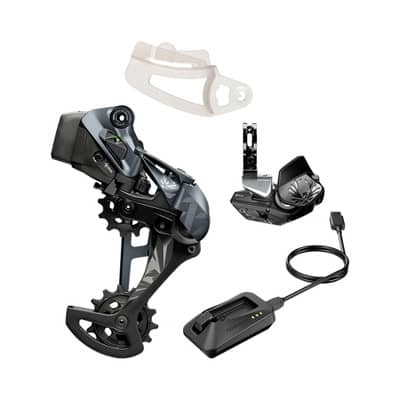Shift groups
The shifting group has the task of making cycling as pleasant as possible. It consists of several components and allows you to change gears on the chain pinions. Basically, there are three variants: derailleur gears, hub gears and bottom bracket gears. The derailleur is the classic among the gear groups. You can find out more about the different gear types here.
-18%
2,450.00 1,999.00 €*
free shipping
In stock, available
1,300.00 €*
free shipping
In stock, available
-13%
3,999.00 3,499.00 €*
free shipping
In stock, available
2,715.00 €*
free shipping
In stock, available
SALE -{{UVPPercentDiscount}}%
-{{UVPPercentDiscount}}%
new {{jahr}}
{{#UVP}} {{UVP}} {{/UVP}} {{record.Preis}}*
{{#FreeShipping}} free shipping {{/FreeShipping}} {{^FreeShipping}} excl. shipping costs {{/FreeShipping}}
{{^onStock}}Lieferzeit: {{/onStock}}{{record.Lieferbarkeit}}
- {{caption}}
- {{caption}}
- {{caption}}
- {{caption}}
- ...
- {{caption}}
- ...
- {{caption}}
- {{caption}}
- {{caption}}
- ...
- {{caption}}
- {{caption}}
- ...
- {{caption}}
- {{caption}}
- {{caption}}
- {{caption}}
Derailleur gears: traditional versatility
Derailleur gears are the most commonly used gears on bicycles. It uses a chain and a combination of chainrings in the front and sprockets in the rear to change gears. This type of gearing offers a wide range of gears and is especially found on road bikes, mountain bikes, and many other types of bicycles.
Advantages of derailleur gears:
-
Wide range: derailleurs offer a wide range of gears suitable for different terrains and speeds.
-
Efficient power transmission: Direct linkage through the chain allows for efficient power transfer to the wheels.
-
Light weight: derailleurs are often lighter than other types of gears.
Disadvantages of derailleur gears:
-
Maintenance: derailleurs require regular maintenance due to wear and adjustments.
-
Contamination: The open design of derailleurs makes them susceptible to contamination and wear.
Hub gears: Easy operation and maintenance
Hub gears use an internal gear system in the rear hub area. This gear system is especially popular on city bikes and touring bikes.
Advantages of hub gears:
-
Less maintenance: hub gears require less maintenance because they sit in a closed unit and are protected from dirt.
-
Ease of use: gears are changed at rest, which is especially convenient for riding in stop-and-go traffic or hilly terrain.
-
Low wear: the internal design minimizes wear and extends the life of the gears.
Disadvantages of hub gears:
-
Weight: hub gears are often heavier than derailleurs.
-
Limited ge ars: hub gears usually offer fewer gears than derailleurs.
Bottom bracket gears: For specialized applications.
Bottom bracket shifting is a rare shifting option where the gears sit directly in the bottom bracket. It is often used in combination with belt drives or on specialized types of bikes such as recumbents.
Advantages of bottom bracket shifting:
-
Good weight distribution: bottom bracket gears can provide an even weight distribution, which has a positive effect on riding characteristics.
-
Low maintenance: similar to hub gears, bottom bracket gears require less maintenance.
Disadvantages of bottom bracket gears:
-
Limited availability: bottom bracket gears are less common and can be harder to find.
-
Customization: Adjusting bottom bracket gears can be more challenging and require specialized knowledge.
Mechanical vs. electronic shifting: the digital revolution
Difference between mechanical and electronic shifting:
Mechanical sh ifters work with cables that connect the shifters to the rear derailleur and front derailleur and run along or through the frame.
The advantages of electronic shifting are more precise shifting, easier operation of the shift levers, high usability, higher shifting speed, and high functionality. The disadvantages compared to the mechanical version are the need for a charged battery and a higher purchase price.
Before you decide, you should try different options, get expert advice and make sure that the gear system you choose fits your bike and your riding style.









